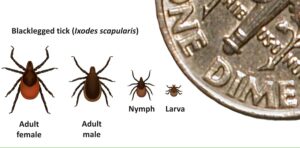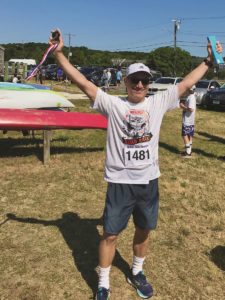WELLFLEET — Life on Cape Cod includes ticks — and increasingly, tick-borne diseases.

According to the state Dept. of Public Health, 113 people on Cape Cod were diagnosed with illnesses they got from ticks in 2024. There are probably a few hundred more people who weren’t diagnosed — the Centers for Disease Control estimates that for every one case of Lyme disease that is officially reported six or seven more people contract the disease.
State data also show that most emergency room visits related to tick-borne diseases occur from June to August. But winter’s arrival doesn’t mean we are completely safe from ticks. Adult deer ticks — also known as black-legged ticks — can be active any time temperatures are above 40° F, and they are the type of tick most likely to carry Lyme disease.
“There’s concern that with climate change and warming winters, we could see even more tick-borne disease,” said Lea Hamner, a contract epidemiologist for Barnstable County. “We need to be attuned to preventing tick bites all year long.”
Winter Ticks
Lyme disease is particularly debilitating. Most cases are relatively mild, with symptoms including rash, fever, headaches, muscle aches, and swollen lymph nodes — but in 10 to 20 percent of cases, these symptoms expand to include severe fatigue, neurological damage, swollen joints, facial palsy, cognitive problems, and depression, according to Columbia University’s Lyme and Tick-Borne Diseases Research Center.
Even with treatment, these severe cases, which are sometimes called “chronic Lyme,” can last for months or years.
The deer ticks that carry Lyme disease are primarily found in habitats with a lot of leaf litter, particularly at the edge of forests. A larger species, the dog tick, is found primarily in grassy meadows and dunes, according to Dukes County biologist Patrick Roden-Reynolds.
Deer ticks have three life stages: just-hatched larvae, one-year-old nymphs, and two-year-old adults. To transition between these life stages, Hamner said, a tick must consume a meal of blood.
Each time a tick latches onto a host to eat, there is a chance it will contract the Lyme-causing borrelia bacteria from its host. The primary reservoirs of Lyme disease on Cape Cod are shrews and white-footed mice, Hamner said. According to the Cary Institute of Ecosystem Studies in New York’s Hudson Valley, between 40 and 90 percent of deer ticks that feed on mice will contract the disease.
With each successive blood meal, the chance that a deer tick has bitten a host with Lyme disease increases, said Hamner. That means adult ticks are the most likely to carry the disease — and adults typically emerge in the fall and can be active all winter until late May, when female deer ticks lay their eggs.
“They’re spending their winters looking for a blood meal,” Hamner said.
Most other tick species die or hibernate at that time of year, so if you’re bitten by a tick in the winter, it’s almost certainly a deer tick, Roden-Reynolds said. A 2022 study led by ecoimmunologist Laura Ferguson from Dalhousie University found that Lyme disease helps deer ticks survive the winter — in that experiment, 80 percent of infected ticks survived the winter, while only 50 percent of uninfected ticks did so.
Deer ticks can also transmit other diseases, including a parasitic illness that can destroy red blood cells and cause anemia. That disease, babesiosis, is rare — Lyme disease is by far the most abundant tick-borne illness, Roden-Reynolds said.
Reports of tick-borne illnesses in winter are also rare, according to state data. Hamner ascribes this to changes in human behavior: “We’re less active outdoors, and we’re wearing clothing and layers” in winter, she said.
Continually warming winters mean that more people will be outside, Hamner said. “If humans also become more active in the winter, doing outdoor things and not practicing tick bite prevention, then we could reasonably expect more tick diseases.”
Population Surge
According to Roden-Reynolds, deer ticks were not common here in the early 20th century. The most common type of tick in New England was the dog tick, which can carry the bacteria that causes Rocky Mountain spotted fever, a dangerous but exceedingly rare condition. (From 1995 to 2017, Massachusetts lists only nine cases.)
During the 1960s, ’70s, and ’80s, deer tick populations exploded, Roden-Reynolds said, and with them the incidence of Lyme disease. In 2009 there were over 4,000 reported cases of Lyme in Massachusetts, leading the state House of Representatives oversight committee to call it a public health crisis. In 2022, that number had climbed to over 5,000, according to the Mass. DPH.
The exact cause of this increase is unknown, Roden-Reynolds said, but the likely explanation is a recovery in the population of host species and changes in habitat.
Some of the deer tick’s main host species, including deer and turkeys, had been hunted to near-extinction by the early 1900s. Conservation movements sprung up to help them recover, and hunting also declined in popularity.
As a result, wild turkeys went from a population of only 30,000 in all of North America in the early 1900s to 7 million in 2023, according to the Nature Conservancy. Deer rebounded similarly: from 215,000 in the whole country in the early 1900s, according to the U.S. Forest Service, to almost that many just in Massachusetts last year.
Land use changes also mattered, as farmland turned into forests and suburbs and towns expanded. This process created more of the forest-edge habitats that deer ticks need, Roden-Reynolds said, and increased the population of the rabbits, squirrels, deer, and turkeys that ticks feed on.
“By expanding human society, we’ve developed this habitat that’s just wonderful for tick hosts,” he said.
Permethrin
Hamner and Roden-Reynolds both said that the best way to prevent tick bites was by wearing permethrin-treated clothing.
Clothes treated with this chemical are “unlikely to pose any significant immediate or long-term hazard,” according to the Environmental Protection Agency, and they are remarkably effective at preventing bites. A 2018 study by the Centers for Disease Control found that ticks are killed or incapacitated within one minute of contact with permethrin and are often still unable to bite an hour after exposure.
Hamner said that repellents like DEET can be effective as well, and tucking pant legs into socks and checking for ticks after being out in the field can also help.
When combined, these personal protection measures can be remarkably effective.
“Tick bites are totally preventable,” said Roden-Reynolds, whose job on Martha’s Vineyard involves collecting ticks in forests and dunes. “I’ve been here three years, and I’ve not had a single tick bite.”

